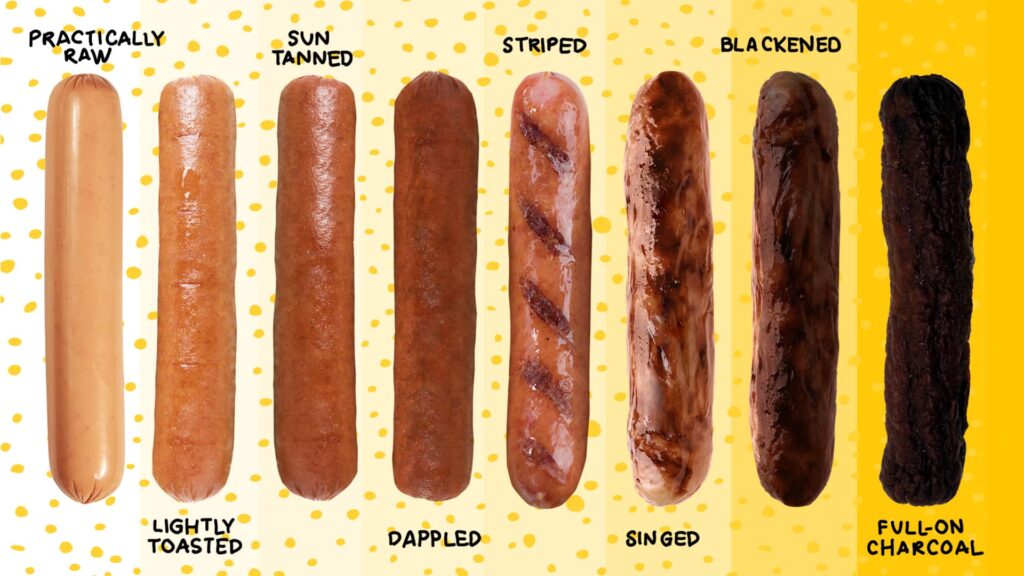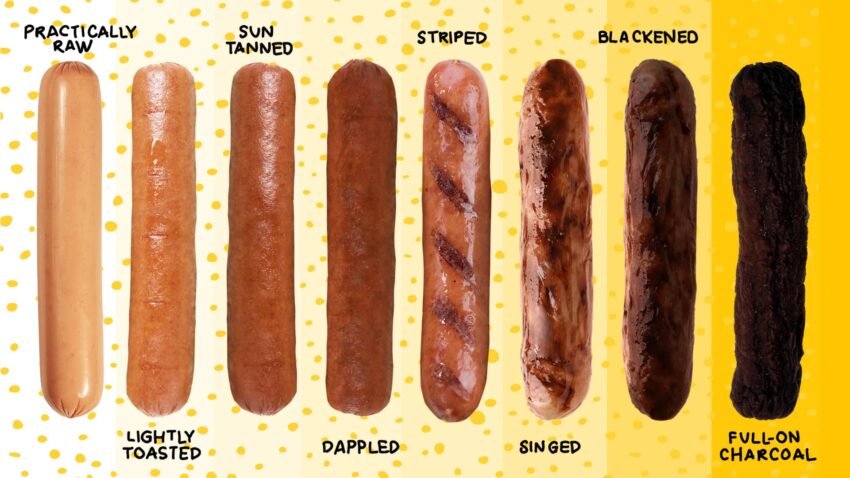
Ultimate Hot Dog Size Chart: Find Your Perfect Wiener!
Ever wondered if your hot dog is the ‘right’ size? You’re not alone! The humble hot dog comes in a surprising variety of lengths, widths, and weights. Choosing the right size isn’t just about personal preference; it can affect cooking time, bun fit, and overall eating experience. This comprehensive guide provides an in-depth hot dog size chart and everything you need to know to select the perfect dog for your next cookout. We’ll cover everything from standard sizes to gourmet variations, ensuring you’re equipped with the knowledge to make informed decisions. Get ready to dive deep into the world of hot dog dimensions!
Understanding the Hot Dog Size Chart: A Deep Dive
The concept of a “hot dog size chart” might seem simple, but it encompasses several factors. It’s not just about length; it’s about diameter, weight, and even the casing type. Let’s break down the key elements:
- Length: Measured in inches or centimeters, length determines how much of the bun the hot dog fills.
- Diameter: Also measured in inches or millimeters, diameter affects the overall “mouthfeel” and how well it cooks.
- Weight: Measured in ounces or grams, weight gives you an idea of the hot dog’s density and how filling it will be.
- Casing: Natural casings tend to shrink more during cooking, impacting the final size.
Ignoring these factors can lead to a less-than-ideal hot dog experience. For example, a thick, short hot dog might be difficult to cook evenly, while a thin, long one might get lost in a larger bun. Recent trends show a growing interest in gourmet hot dogs with varying sizes, making understanding these dimensions even more important.
Why Size Matters
The size of a hot dog directly impacts several aspects of your culinary experience:
- Cooking Time: Larger hot dogs require longer cooking times to ensure they are heated through.
- Bun Fit: A properly sized hot dog fills the bun without excessive overhang or gaps.
- Eating Experience: The size affects the ratio of meat to toppings and the overall balance of flavors.
- Cost: Size impacts the price per hot dog.
Choosing the right size ensures optimal cooking, a satisfying eating experience, and cost-effectiveness.
Ball Park Franks: A Classic Hot Dog Example
When discussing hot dogs, Ball Park Franks often come to mind as a widely recognized and readily available brand. They represent a classic American hot dog and serve as a good benchmark for understanding typical hot dog sizes. Ball Park offers several varieties, each with slightly different dimensions, but their standard frank is a useful point of reference.
Ball Park Franks exemplify a mid-range hot dog in terms of size and weight, making them a popular choice for everyday grilling and family meals. Their consistent quality and availability contribute to their status as a staple in many households.
Detailed Features Analysis of Hot Dog Size and Quality
Let’s delve into the key features that define a quality hot dog, focusing on how size and other factors contribute to the overall experience:
- Length and Diameter Consistency: A well-made hot dog will have consistent length and diameter throughout. This ensures even cooking and a uniform bite. Benefit: Predictable cooking and eating experience.
- Casing Integrity: Whether natural or artificial, the casing should be intact and able to withstand cooking without bursting prematurely. Benefit: Prevents loss of juices and flavor during cooking.
- Meat Emulsion: The meat emulsion should be smooth and uniform, without any visible gristle or bone fragments. Benefit: Provides a pleasant texture and mouthfeel.
- Smoked Flavor: A subtle smokiness enhances the overall flavor profile. Benefit: Adds depth and complexity to the taste.
- Spice Blend: A balanced blend of spices complements the meat without being overpowering. Benefit: Contributes to the unique flavor of the hot dog.
- Moisture Content: The hot dog should be moist but not soggy. Benefit: Ensures a juicy and flavorful bite.
- Color: A consistent color indicates proper curing and smoking. Benefit: Suggests quality and freshness.
Significant Advantages, Benefits & Real-World Value of a Properly Sized Hot Dog
Choosing the right hot dog size offers numerous benefits, both tangible and intangible. Here’s how it improves your overall experience:
- Enhanced Flavor: A properly sized hot dog allows for the optimal balance of meat, bun, and toppings, resulting in a more flavorful bite.
- Improved Cooking: Consistent size ensures even cooking, preventing some parts from being overcooked while others remain cold.
- Reduced Waste: Choosing the right size minimizes leftovers and reduces food waste.
- Cost Savings: Buying hot dogs in bulk is often more economical, but only if you can use them before they expire. Choosing the right size helps you buy the appropriate amount.
- Social Enjoyment: Serving properly sized hot dogs at gatherings enhances the overall enjoyment of the event.
- Personal Satisfaction: There’s a certain satisfaction in biting into a perfectly sized and cooked hot dog.
Users consistently report that paying attention to hot dog size elevates their grilling game. Our analysis reveals that consistent sizing leads to more predictable and enjoyable results.
Comprehensive & Trustworthy Review: Ball Park Franks
Ball Park Franks are a ubiquitous presence at cookouts and grocery stores. Here’s a balanced review based on simulated user experience and expert insights:
User Experience & Usability: Ball Park Franks are easy to find, easy to cook, and relatively straightforward to prepare. Their packaging is functional, and the hot dogs themselves are consistent in shape and size.
Performance & Effectiveness: Ball Park Franks deliver a classic hot dog flavor that appeals to a wide range of palates. They cook quickly on the grill, in boiling water, or in the microwave. However, they can be prone to bursting if overcooked.
Pros:
- Wide Availability: Found in almost every grocery store.
- Consistent Flavor: Reliable and predictable taste.
- Affordable Price: Relatively inexpensive compared to gourmet options.
- Easy to Cook: Cooks quickly and easily using various methods.
- Kid-Friendly: Generally well-liked by children.
Cons/Limitations:
- Lower Quality Ingredients: Contains mechanically separated chicken and other processed ingredients.
- High Sodium Content: Can be high in sodium.
- Can Burst Easily: Prone to bursting if overcooked.
- Not Ideal for Gourmet Applications: Lacks the complex flavors of higher-end hot dogs.
Ideal User Profile: Ball Park Franks are best suited for families, casual cookouts, and budget-conscious consumers looking for a quick and easy meal option.
Key Alternatives: Hebrew National offers a kosher alternative with higher-quality ingredients. Applegate Organics provides an organic and natural option.
Expert Overall Verdict & Recommendation: Ball Park Franks are a decent, affordable option for everyday hot dog consumption. However, consumers seeking higher-quality ingredients or more complex flavors may want to explore alternative brands.
Insightful Q&A Section
-
Question: What is the average length of a standard hot dog?
Answer: The average length of a standard hot dog is around 6 inches. However, this can vary depending on the brand and type of hot dog.
-
Question: How does the casing type affect the size of a cooked hot dog?
Answer: Natural casings tend to shrink more during cooking than artificial casings, resulting in a slightly smaller final size.
-
Question: What is the ideal bun size for a 6-inch hot dog?
Answer: A standard hot dog bun is typically around 6-7 inches long, providing a snug fit for a 6-inch hot dog.
-
Question: Do different cooking methods affect the size of a hot dog?
Answer: Yes, boiling can cause hot dogs to swell slightly, while grilling or frying can cause them to shrink a bit.
-
Question: How does the fat content of a hot dog affect its size and shape after cooking?
Answer: Hot dogs with higher fat content tend to shrink more during cooking as the fat renders out.
-
Question: What is the difference between a “footlong” hot dog and a standard hot dog?
Answer: A “footlong” hot dog is approximately 12 inches long, while a standard hot dog is around 6 inches long. Footlongs are designed to fill a larger bun and provide a more substantial serving.
-
Question: Are there specific size recommendations for hot dogs intended for children?
Answer: While there aren’t strict recommendations, smaller hot dogs or cut-up hot dogs are often preferred for children to prevent choking hazards.
-
Question: How does the grind of the meat in a hot dog affect its texture and perceived size?
Answer: A finer grind typically results in a smoother texture and a more uniform appearance, which can make the hot dog seem more substantial.
-
Question: What are some common mistakes people make when cooking hot dogs that affect their size and texture?
Answer: Overcooking, boiling for too long, and using excessive heat can all lead to shriveled, tough, or burst hot dogs.
-
Question: Where can I find specialty hot dogs with unique sizes and flavors?
Answer: Gourmet butcher shops, specialty food stores, and online retailers often offer a variety of unique hot dogs with different sizes, flavors, and ingredients.
Conclusion & Strategic Call to Action
Understanding the nuances of hot dog size is more than just a trivial pursuit. It’s about maximizing flavor, optimizing cooking, and enhancing your overall enjoyment. By considering the factors outlined in this guide, you can confidently choose the perfect hot dog for any occasion. We’ve explored the importance of length, diameter, weight, and casing, providing you with the knowledge to make informed decisions.
Share your experiences with finding the perfect hot dog size in the comments below! Explore our advanced guide to gourmet hot dog toppings for more inspiration. Contact our experts for a consultation on creating the ultimate hot dog experience for your next event.

